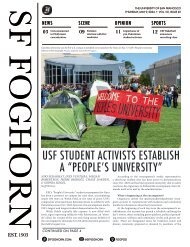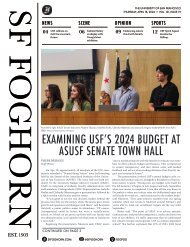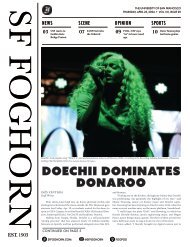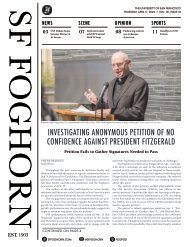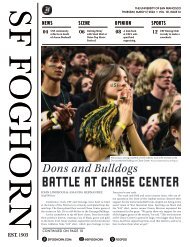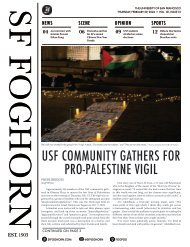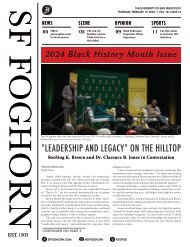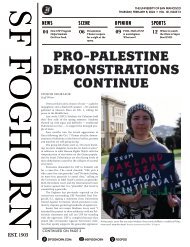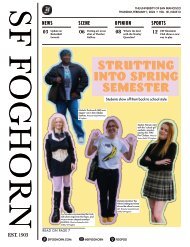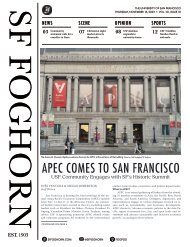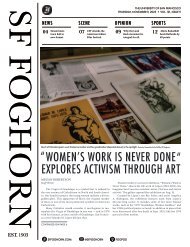VOL 120, ISSUE 16 - March 9th, 2023
You also want an ePaper? Increase the reach of your titles
YUMPU automatically turns print PDFs into web optimized ePapers that Google loves.
SF FOGHORN<br />
EST. 1903<br />
03<br />
SFFOGHORN.COM<br />
FOGPOD<br />
NEWS<br />
Women lead climate<br />
activism at USF.<br />
05<br />
@SFFOGHORN<br />
SCENE OPINION SPORTS<br />
Girl Gains makes room<br />
for women in fitness.<br />
THE UNIVERSITY OF SAN FRANCISCO<br />
THURSDAY, MARCH 9, <strong>2023</strong> • <strong>VOL</strong>. <strong>120</strong>, <strong>ISSUE</strong> <strong>16</strong><br />
09<br />
THE DRIVER ERA<br />
Full story on page 8<br />
We need to normlize<br />
periods.<br />
11<br />
Coaches need more<br />
compassion<br />
DELIVERS AT DONAROO<br />
(Bottom left and top right) Rocky Lynch and Ross Lynch of The Driver Era; (bottom right) Rayyana Sherif, Jalyn Correla, and Jasmine Munyui pose for CAB’S<br />
photobooth. PHOTOS COURTESY OF DYLAN DIVINE-SICHERMAN/SLE MARKETING TEAM AND JORDAN PREMMER/SF FOGHORN<br />
Inside: Women's History Month focused issue
02<br />
THURSDAY<br />
MAR 9,<br />
<strong>2023</strong><br />
STAFF<br />
SUBMISSION POLICY<br />
The San Francisco Foghorn is the<br />
official student newspaper of the<br />
University of San Francisco and is<br />
sponsored by the Associated Students<br />
of the University of San Francisco<br />
(ASUSF).<br />
The thoughts and opinions expressed<br />
herein are those of the individual writers<br />
and do not necessarily reflect those<br />
of the Foghorn staff, the administration,<br />
the faculty, staff or the students<br />
of the University of San Francisco.<br />
Contents of each issue are the sole<br />
responsibilities of the editors.<br />
An All-American<br />
Publication<br />
ad maiorem dei<br />
gloriam<br />
415.422.5444<br />
sffoghorn.com<br />
The San Francisco Foghorn is free of<br />
charge.<br />
Advertising matter printed herein is<br />
solely for informational purposes.<br />
Such printing is not to be construed<br />
as written or implied sponsorship<br />
or endorsement of such commercial<br />
enterprises or ventures by the San<br />
Francisco Foghorn.<br />
©MMIV-MMV, San Francisco Foghorn.<br />
All rights reserved. No material<br />
printed herein may be reproduced<br />
without prior permission of the Editor<br />
in Chief.<br />
SAN FRANCISCO<br />
FOGHORN<br />
Freedom and Fairness<br />
Editor in Chief<br />
ZOE BINDER<br />
zebinder@dons.usfca.edu<br />
News Editor<br />
NIA RATLIFF<br />
mnratliff@dons.usfca.edu<br />
Opinion Editor<br />
OLIVER RIVER SATALICH<br />
omriversatalich@dons.usfca.edu<br />
Scene Editor<br />
JORDAN PREMMER<br />
jepremmer@dons.usfca.edu<br />
Sports Editor<br />
JOHN PAOLO<br />
jnpaolo@dons.usfca.edu<br />
Photography Editor<br />
DOMINIQUE CADENAS CALVO<br />
dicadenascalvo@dons.usfca.edu<br />
General Reporter<br />
JORDAN DELFIUGO<br />
jgdelfiugo@dons.usfca.edu<br />
General Reporter<br />
SOPHIA MCCRACKIN<br />
smmccrackin@dons.usfca.edu<br />
Managing Editor<br />
NORA WARD<br />
naward2@dons.usfca.edu<br />
Copy Editor<br />
SAVANNAH DEWBERRY<br />
skdewberry@dons.usfca.edu<br />
Layout Editor<br />
AVA LORD<br />
ajlord@dons.usfca.edu<br />
Layout Editor<br />
KRISTEN JOHNSON<br />
kjohnson20@dons.usfca.edu<br />
Social Media Manager<br />
MARIA ZAIED<br />
mfzaied@dons.usfca.edu<br />
Online Editor<br />
HAYLEY DIEMAR<br />
htdiemar@dons.usfca.edu<br />
Advisor<br />
TERESA MOORE<br />
2130 FULTON STREET, UC #417<br />
SAN FRANCISCO, CA 94117<br />
Columns for the Opinion section<br />
and Letters to the Editor are gladly<br />
accepted from students, faculty, staff<br />
and alumni.<br />
All materials must be signed and<br />
include your printed name, university<br />
status (class standing or title), address,<br />
and telephone number for verification.<br />
Anonymous submissions are not<br />
published.<br />
We reserve the right to edit materials<br />
submitted. All submissions become the<br />
property of the San Francisco Foghorn.<br />
Staff editorials are written by the<br />
Foghorn editorial staff and represent a<br />
group consensus.<br />
The San Francisco Foghorn Opinion<br />
page is a forum for the free, fair and<br />
civil exchange of ideas. Contributors’<br />
opinions are not meant to reflect<br />
the views of the Foghorn staff or the<br />
University of San Francisco.<br />
Students interested in contributing to<br />
the Foghorn can scan and fill out the<br />
QR code below.<br />
STAFF EDITORIAL<br />
WOMEN IN JOURNALISM<br />
DESERVE OUR RESPECT<br />
Journalism is<br />
one of many industries<br />
that has<br />
historically excluded<br />
women,<br />
but gender diversity<br />
in newsrooms<br />
across the country<br />
is on the rise.<br />
With increased<br />
diversity in newsrooms<br />
comes increased<br />
diversity<br />
in stories, and a<br />
healthier news<br />
media overall.<br />
Newsrooms are the most gender-diverse<br />
they’ve ever been. Neiman Lab reported<br />
that in 1971, women made up only 22%<br />
of daily newspaper journalists, and 11% of<br />
television journalists. But as of 2019, according<br />
to the News Leaders Association’s<br />
diversity survey, 41.8% of all newsroom<br />
workers are women.<br />
However, non-white women continue<br />
to be underrepresented in newsrooms. In<br />
a study conducted by the American Society<br />
of News Editors across 661 newsrooms,<br />
under 3% of their journalists were Black<br />
women. Hispanic women and Asian women<br />
both made up about 2%, and Native<br />
American and Hawaiian/Pacific Islander<br />
women combined accounted for less than<br />
1%. Although white women are a minority<br />
compared to the men who dominate the<br />
industry, they are better represented than<br />
women of color.<br />
While there has been an increase in female<br />
journalists, there has not been an<br />
increase in respect. In a 2022 study from<br />
UNESCO, 73% of female journalists reported<br />
receiving online harassment, and<br />
25% received threats of physical violence.<br />
Journalists who were women of color, or<br />
LGBT identifying, experienced the highest<br />
rates and most severe of online threats.<br />
The lack of respect for female journalists<br />
is so deeply imbued into our culture that it<br />
has infiltrated popular media, which refuses<br />
to take women in journalism seriously.<br />
The clearest image some of our generation<br />
might have of what it means to be a<br />
female journalist comes from the poor caricatures<br />
that plague Hollywood. Romantic<br />
comedies like “How to Lose a Guy in Ten<br />
Days” (2003) and “Trainwreck” (2015)<br />
paint female journalists as fluffy writers<br />
with little else to do than pursue a man<br />
— who often ends up being their article’s<br />
subject. As said in the Atlantic, sleeping<br />
with sources is a tired trope that has been<br />
hashed and rehashed ten times over. This<br />
is especially egregious when real life journalists<br />
are falsely portrayed this way, as the<br />
late journalist Kathy Scruggs was in Clint<br />
Eastwood’s 2019 film “Richard Jewell.”<br />
PHOTO COURTESY OF WIKIMEDIA COMMONS<br />
It’s not that fluffy stories are inherently<br />
bad, but they’re not all that female journalists<br />
are capable of writing. Women have a<br />
long history of making strides in journalism,<br />
one that deserves a reputation beyond<br />
Hollywood tropes.<br />
Ida B. Wells-Barnett was a prominent<br />
journalist in the late 1<strong>9th</strong> century who<br />
covered and spoke out about the horrible<br />
lynchings Black Americans faced from their<br />
white counterparts. Wells, who was born<br />
into slavery, was one of the first journalists<br />
to push back against white supremacy in<br />
the press, which led to threats against her<br />
life. She was a trailblazer, not only for women<br />
but for her entire field, and was finally<br />
honored by a Pulitzer prize posthumously<br />
in 2020.<br />
In 2017, Jodi Kantor and Megan Twohey<br />
of the New York Times wrote a story that<br />
changed womens’ lives for the better. The<br />
piece, which detailed the experiences of several<br />
women who were sexually harassed by<br />
(formally successful) Hollywood producer<br />
Harvey Weinstein, sparked the #MeToo<br />
movement.<br />
Last year, Politico recapped tangible<br />
changes the #MeToo movement made for<br />
women and other vulnerable groups and<br />
other vulnerable groups. They reported<br />
that, “Between 2017 and 2021, states introduced<br />
2,324 #MeToo-related bills and<br />
passed 286,” including bills championing<br />
anti-harassment practices and pay equity.<br />
Increasing female representation in journalism<br />
means that women, who make up<br />
about half of the world’s population, can<br />
tell their stories on their own terms. Journalists<br />
cover stories that will eventually<br />
be referred to in history books, and they<br />
should reflect the nuanced identities of the<br />
cultures they represent.<br />
Although women still face challenges<br />
in journalism, trailblazers like Wells, Kantor,<br />
Twohey, and so many others have set<br />
the precedent that female journalists can<br />
do great things. As a primarily female-led<br />
publication, the Foghorn will continue to<br />
uphold the values of great female journalists<br />
before us and continue to pave the way for<br />
this change to occur.<br />
WOMEN AND THE CLIMATE JUSTICE<br />
MOVEMENT AT USF<br />
JORDAN DELFIUGO<br />
Staff Writer<br />
Women, especially women of color, have historically played an instrumental<br />
role in environmental activism. For Women’s History Month, the Foghorn is<br />
reflecting on how women at USF are forging a better future through intersectional<br />
environmental activism on campus and beyond.<br />
Since the 1970s, environmental researchers have recognized a coinciding<br />
relationship between society’s exploitation of women and its exploitation of<br />
the environment. In the United Nations’ 2030 Agenda for Sustainable Development,<br />
a 17 item plan that outlines necessary steps for a more sustainable<br />
future, gender equality is named as a “necessary foundation for a peaceful,<br />
prosperous, and sustainable world.”<br />
Media studies professor Dorothy Kidd has been involved in this movement<br />
for most of her life, first participating in youth activism and research<br />
in the 1970s. “There was this idea in the 1970s that not only did we need to<br />
be feminist to change the world, but we needed to have an understanding of<br />
changing the environment,” said Kidd.<br />
Kidd continues to advocate for environmental justice through her research<br />
on extractivism, the removal of large quantities of natural materials<br />
for export. In addition to her research, Kidd centers environmental issues and<br />
communications in her teaching.<br />
Adrienne Johnson, an environmental studies professor, also works to<br />
incorporate climate justice in her classes. “I’ve designed and taught a class<br />
on gender and the environment and I really hope students take away that<br />
environmental issues are highly political ones,” she said. “I employ an intersectional<br />
lens, meaning I hope students walk away understanding how<br />
your personal identity can shape to what extent you have access to a healthy<br />
environment or not.”<br />
Though climate change affects everyone, women are exceedingly vulnerable<br />
to the effects of environmental destruction. Damage to the environment<br />
puts women at an increased susceptibility to health ailments, such as malaria<br />
and the Zika virus, which are linked to miscarriages and anemia in women.<br />
Women are also spatially and socially affected by climate change. The<br />
UN estimates that 80% of people displaced as a result of environmental destruction<br />
are women. Additionally, a 2020 study published by the British<br />
Medical Journal found that natural disasters increase the rate of gender-based<br />
violence for women and girls. Johnson’s current research centers around missing<br />
and murdered Indigenous women and girls and the oil extraction industry.<br />
On campus, female students are also actively working to promote climate<br />
justice. Hiveminders is a woman-led and BIPOC run environmental<br />
student group that practices beekeeping on campus. Hiveminders President<br />
and fourth-year environmental studies major Miya Stephanoff described the<br />
Last semester’s Nature Immersion class at Point Reyes National Seashore. PHOTO COURTESY OF SARAH WHITWAM<br />
club as a “safe space for queer BIPOC students.”<br />
Stephanoff said that mindfulness plays a central role in the club’s operations.<br />
“It is simply a joyous and wholesome time, which is something necessary<br />
but not often found,” she said. “Our club focuses on making those<br />
joyous moments happen which is its own form of climate activism.”<br />
Current research suggests that the practice of mindfulness can serve as<br />
a form of environmental activism. According to the American Psychological<br />
Association, the practice can help facilitate a stronger connection to the environment<br />
and subsequently promote more sustainable behaviors.<br />
Another woman and non-binary led student organization on campus<br />
is BIPOC for the Environment. The club was started at USF in 2018 after<br />
its founder, USF class of 2020 alumna Darla Mariduena, identified a lack of<br />
diversity in USF’s environmental departments. The club works to expand the<br />
presence of people of color in the environmental programs on campus, as well<br />
as in the movement as a whole.<br />
“It’s important to be educated and involved in order to salvage our communities<br />
and our homes,” said Beatrice Johnson-Drysdale, third-year engineering<br />
major and the club’s director of operations. “Women have a nurturing<br />
and empathetic gift that we need more of in environmental activism if we<br />
want to make our earth a more sustainable place.”<br />
Other environmental clubs at USF, like the Environmental Engineering<br />
and Science Club, and Strategies for Ecology Education, Diversity, and Sustainability<br />
(SEEDS), are also led by women.<br />
Outside of campus clubs, students like Rachel Struer, a fourth-year environmental<br />
studies major, are highly involved in environmental activism.<br />
Struer works in the Office of Sustainability and previously worked as a teaching<br />
assistant for nature immersion, a class that promotes deepening people’s<br />
connection to nature through class trips in Northern California.<br />
The class is taught by environmental studies professor Kim Carfore, who<br />
specializes in the relationship between women and the environment. “[Carfore]<br />
focuses a lot of her work and in our class on slowing down and pulling<br />
ourselves out of all the little distractions and different tugs that our modern,<br />
technological, capitalist world teases us with,” Struer said. “[We] just back<br />
into ourselves and then out into the real, tangible, beautiful world.”<br />
Stephanoff also expressed admiration for Carfore and the female faculty<br />
in the environmental studies department. “Novella Carpenter and Kim<br />
Carfore are two professors who have inspired me to live with climate justice<br />
close to my heart,” she said. “They encouraged me to find and listen to my<br />
intuition which has already led me to connect with so many powerful women<br />
on campus who all care so deeply for the environment.”<br />
The empathetic influence of women in environmental activism is something<br />
Struer said she admires. “[Women] focus on the fact that this place is<br />
our home and we are all connected together,” she said. “It’s empathy that will<br />
move us forward.”<br />
03<br />
NEWS
04<br />
THURSDAY<br />
MAR 9,<br />
<strong>2023</strong><br />
USF MENA COMMUNITY RESPONDS TO<br />
TURKEY-SYRIA EARTHQUAKES<br />
GIRL GAINS EMPOWERS<br />
WOMEN IN FITNESS<br />
05<br />
NEWS<br />
AMINA ANSHASI<br />
Staff Writer<br />
After a series of devastating earthquakes shook Turkey and Syria<br />
last month, the USF community has been mobilizing relief efforts and<br />
extending support to the affected communities.<br />
A week after the initial earthquake, the University Ministry held<br />
a vigil in Privett Plaza. Reverend Dr. Ronné Wingate Sims helped organize<br />
the vigil which saw about 25 people in attendance. Sims recalled<br />
the events of the vigil in an interview, describing the mood to be “somber<br />
but hopeful,” explaining that “disasters like this are a time for us<br />
to rise to the highest level of humanity possible to serve one another.”<br />
After opening in prayer, the Ministry extended their condolences<br />
to the lives lost in the earthquakes, and expressed their solemn hope<br />
that more people would be found alive.<br />
Over 50,000 people across Turkey and Syria died after the earthquakes<br />
struck the region. As bodies are still being identified and pulled<br />
from the rubble, the number of deaths continues to increase. The original<br />
quake struck in the early morning hours of February 6, and clocked<br />
in at 7.8 on the Richter scale, a quantitative measure of an earthquake’s<br />
size. In the following hours and days, hundreds of aftershocks were<br />
recorded, some with magnitudes as large as 6.7.<br />
Rescue teams from across the globe flew in to save people from the<br />
rubble and international relief efforts began collecting funds, clothing,<br />
food, and other supplies to support the displaced and affected.<br />
Bati Ozcan, associate director of USF Athletics and a Turkish native,<br />
spoke at the vigil. Ozcan survived the 7.4 earthquake that struck<br />
Turkey in 1999, making this disaster especially near to him. Ozcan’s<br />
family in Turkey was safe after the recent earthquake.<br />
The University Ministry distributed slips of dissolvable paper to<br />
Ari Acheckzai and Tiffany Boudagin table with MENA to raise funds and awareness for those affected by the earthquakes. PHOTO<br />
COURTESY OF THE USF MENA CLUB<br />
the vigil attendees to write prayers. The prayers were collected, dissolved<br />
in water, and poured into a plant. Reverend Sims explained how<br />
this served to illustrate that as the water nourished life here, in San<br />
Francisco, the prayers would hopefully nourish life in the affected areas<br />
of Turkey and Syria.<br />
That following Sunday, Feb. 19, USF’s liturgy team organized<br />
prayers for a student-led mass and accepted donations for the affected<br />
regions. However, many USF community members sought out more<br />
ways to support the relief efforts.<br />
USF’s Middle East/North African Club (MENA) hosted a student-led<br />
table outside of Lo Schiavo. Both MENA’s leadership and<br />
members of the club tabled from 11 a.m. to 5 p.m. every school day between<br />
Feb. 15 and 24 to help students learn more about the catastrophe<br />
and donate directly to relief funds.<br />
“It was without hesitation that we knew we wanted and needed<br />
to organize informational tables that helped to gain donations and<br />
spread awareness about the earthquakes,” said MENA president Jared<br />
Bisbikis, a fourth-year international studies major. Bisbikis described<br />
wanting to reflect the fact that “USF has a diverse community which<br />
includes Turkish and Syrian students whose families and friends and<br />
community have been affected by this catastrophe.”<br />
One such student is Defne Sagdic, a fourth-year psychology major.<br />
Sagdic, a Turkish student, described feeling emotional after hearing<br />
news of the earthquakes, but immediately wanted to jump into action<br />
and get involved with relief efforts. Sagdic began working with various<br />
organizations on and off campus, including MENA, UC Berkeley's<br />
Turkish Student Association and UC Berkeley, and various Turkish<br />
communities around the Bay Area to coordinate donation sites.<br />
Moving forward, Sagdic encourages students to educate themselves<br />
on the situation and consider donating or getting involved in<br />
organizations, both on and off campus<br />
that are aiding the affected communities.<br />
Sarah Tinawi, a third-year<br />
psychology major, who has relatives<br />
and friends affected by the earthquakes<br />
also advises USF community<br />
members to participate in upcoming<br />
campus events to support relief efforts<br />
and raise awareness, including<br />
a collaborative educational campaign<br />
being worked on by students, faculty,<br />
and school organizations.<br />
This campaign is being kicked<br />
off with a vigil that will be held today,<br />
<strong>March</strong> 9, from 12 to 1 p.m., in Privett<br />
Plaza to honor the lives lost. Another<br />
event students can check out is the<br />
baklava sale on <strong>March</strong> 27 from 10:00<br />
a.m. to 2:00 p.m. in the University<br />
Center undercaf, a joint fundraiser between<br />
MENA, Arab Student Union,<br />
Muslim Student Association, and the<br />
Iranian Student Union. All the funds<br />
will go directly to Turkish and Syrian<br />
relief.<br />
On behalf of MENA, Bisbikis<br />
reminded the USF community that,<br />
“The death toll continues to grow daily<br />
and resources, particularly funds,<br />
are continuing to be needed. If you<br />
are able, we encourage even the smallest<br />
donation. Additionally encouraging<br />
organizations on and off-campus<br />
as well as our institution to raise<br />
awareness and make donations to the<br />
affected communities.”<br />
Girl Gains USFCA celebrates the second anniversary of the club with fellow chapters. PHOTO COURTESY OF GIRLGAINSUSFCA ON INSTAGRAM<br />
SAMANTHA MARQUEZ<br />
Staff Writer<br />
Noticing that you are the only woman in the weight room at a gym<br />
can be intimidating. According to Women’s Health Magazine, one in three<br />
women feel out of place in a gym setting. Enter Girl Gains, a student organization<br />
that promotes female weightlifting and empowerment in fitness.<br />
Girls Gains was originally created at San Diego State University by<br />
then-undergraduate Elizabeth Bradley in 2020 for women with a passion for<br />
fitness. Since then, the club gained over 10,000 followers on social media and<br />
has opened up 83 chapters across the country, including one on the Hilltop.<br />
USF’s chapter was founded in August 2022 by Mia Dawes, who graduated<br />
with a marketing degree last semester, and is open to women with a drive for<br />
fitness looking for a judgment-free space.<br />
Girl Gains USF has planned multiple events such as boxing class events,<br />
lifting buddy group socials, meetings with professional nutritionists, and<br />
group sessions with a personal trainer at Koret Health Center.<br />
Lifting buddy group socials are used for new and recurring members of<br />
Girl Gains to find a gym partner to motivate each other and lift each other<br />
up through those tough workouts. Recently, Girl Gains USF partnered with<br />
Rumble Boxing Group Fitness to do a social event at the studio location in<br />
Cow Hollow.<br />
Zuri Vera Nunez, a fourth-year psychology major and co-marketing director<br />
of Girl Gains, said she grew up as a competitive dancer and faced<br />
scrutiny over her body type. “The industry promotes unhealthy body size expectations<br />
and is predominantly white. As someone who identifies as Latina<br />
and has a curvy body type, I was never able to deeply appreciate my body,”<br />
she said.<br />
Her journey with weightlifting started in 2021, when she was unable<br />
to participate in dance during the pandemic, but she still felt insecure about<br />
herself at the gym. “I was afraid of asking anyone how to use a machine…<br />
I was afraid of how people would perceive me,” she said. Nunez joined Girl<br />
Gains in 2022 and immediately found her place. “I felt both empowered in<br />
myself and hopeful about building a community of women to process the<br />
barriers that we face collectively,” she said. “Everytime I hit a new personal<br />
record, I felt empowered, uplifted, limitless.”<br />
Amrit Kaur, a senior marketing major and member of Girl Gains, goes<br />
to Crunch Daly City, where she self-taught her workout routine, slowly easing<br />
into the routine until she was most comfortable. “It was definitely gym<br />
growing pains. There were days that I didn’t even want to be in the weight<br />
room, because I was the only girl, and I felt as if I didn’t belong, when really,<br />
there shouldn’t be a reason to feel like that,” she said.<br />
She said Girl Gains events, like a group weightlifting workout that focused<br />
on proper and safe form, inspired her to join the group. “It was an<br />
empowering experience and I liked working out with all the girls. They spoke<br />
about their experience in the gym, and it was just nice to hear that I wasn’t<br />
the only one feeling alone.”<br />
The weightroom could seem very daunting if you are going about it<br />
alone, so the members of Girl Gains are there to help and support you every<br />
step of the way. As Nunez said, “[Girl Gains] gets it - they understand the<br />
feelings and thoughts of being in the weight room, but I think because of<br />
that, we don’t judge anyone, we welcome everyone to our indoor and outdoor<br />
events, and make sure to support all your goals.”<br />
To join or support Girl Gains and their events, follow their Instagram account<br />
@girlgainsusfca.<br />
SCENE
06<br />
THURSDAY<br />
MAR 9,<br />
<strong>2023</strong><br />
A COLLEGE STUDENT’S GUIDE<br />
TO COMFORT MEALS<br />
07<br />
SAMANTHA MARQUEZ<br />
Staff Writer<br />
SCENE<br />
Diana Silva-Corral - Pasta with Lemon Chicken<br />
Zoe Wang, a second-year psychology major, shared a social media hit recipe of Chinese<br />
peanut sesame noodles. You can whip up this dish for just $8.<br />
To make: Boil noodles according to package instructions. While boiling, mix together<br />
soy sauce, sesame oil, vinegar, peanut butter, sesame paste, sugar, oyster sauce, chili<br />
oil, garlic, and ginger. Once noodles are cooked, pour noodles and noodle water into the<br />
sauce until desired consistency. Top with green onions, sesame seeds, or personalize it<br />
with your favorite toppings.<br />
Wang learned this recipe from her grandmother, or nai nai in Mandarin. “Because<br />
I grew up mixed, I found a lot of connection to my Chinese heritage through cooking,<br />
and I was able to feel more connected to my grandparents when they taught me their<br />
recipes,” she said.<br />
Wang’s father is a professional chef. Once the COVID-19 pandemic hit, she channeled<br />
all her free time into cooking. She said, “I use cooking as a form of relaxation… the<br />
satisfaction of seeing a dish come together well really provides a sense of fulfillment that<br />
I think anyone could benefit from.”<br />
Joshu a Esk o w - P oke B o wl<br />
If you’re like me, you’re daunted by recipes. Strolling down the aisles of Trader<br />
Joe’s and scanning different ingredients with no idea what to make with them makes<br />
you anxious. Cookbooks seem too intimidating with your limited college kitchen. Especially<br />
with midterms around the corner and essay deadlines piling up, many college<br />
students just want a quick and easy meal. These circumstances pose the question: what<br />
are college-friendly recipes?<br />
Diana Silva-Corral, a second-year politics major, shared her go-to meal: gourmet<br />
tomato pasta with lemon pepper chicken. All ingredients are available at Trader Joe’s,<br />
totaling about $20.<br />
To make: Cook your pasta of choice in boiling water, and prep chicken breasts with<br />
seasonings while pasta is cooking. Put a full tablespoon of salted butter in a heated pan.<br />
Add the well-seasoned chicken breasts into the pan and continue squeezing more lemon<br />
juice so it doesn’t dry and so the lemon flavor stays in the chicken after cooking. Drain<br />
pasta, add butter to the pasta pot and pour the pasta back in. Cut a handful of cherry tomatoes<br />
in half or little squares and sprinkle some Italian seasoning. Add Gournay cheese<br />
into buttered pasta. Add a splash of fat-free milk and the chopped cherry tomatoes into<br />
pasta with the cheese and mix. Add chicken and parmesan.<br />
Silva-Corral has always had a passion for cooking, which originally stemmed from<br />
her parents and grandparents. “I’ve been blessed with a family of great cooks,” she said.<br />
“I grew up watching them do their own recipes and helping every time in the kitchen<br />
however I could.”<br />
Zoe Wang - Sesame Noodles<br />
An easy way to ensure you always have a meal on the go is to meal-prep your<br />
favorite dish. Joshua Eskow, second-year critical diversity studies major, shared with<br />
me his recipe for an ahi tuna pokè bowl. The ingredients cost around $40. However,<br />
the recipe makes more than ten bowls, making each dish about $4 each, and giving<br />
students weeks of a delicious on-the-go meal.<br />
To make: Marinate one ahi tuna cut with some soy sauce, red chili flakes,<br />
minced garlic, fresh ginger, teriyaki sauce, and sesame oil. Let it sit for a bit in the<br />
fridge, or even overnight to make the next day, then sear the ahi tuna on both sides<br />
for two minutes (the inside should be pink while the outside has a nice sear around<br />
it). Finally, put it on top of some cooked rice and add any toppings you’d like, from<br />
avocado to cucumber slices, or even pineapple chunks or kewpie mayo.<br />
Eskow learned this meal from his history of saving money on food before college.<br />
“I have always been a conserver of money as my family did grow up in the struggling<br />
middle class, I started making meals at the age of five with my grandma.” He took over<br />
the kitchen at home after his grandmother’s passing, trying to develop his cooking and<br />
baking skills. Eskow has many passions, but cooking has been a sense of relaxation<br />
for him. “I hope you try to replicate or make your own type of styled poké creation!”<br />
Editor’s note: all recipes can be found on sffoghorn.com.<br />
Color stained Sanjeev Varma, Arni Kulkarni, and Rafiah Shariz couldn’t contain their excitement for Holi. PHOTO COURTESY OF SANJEEV VARMA<br />
HOLI CELEBRATION BRINGS<br />
COLOR TO THE HILLTOP<br />
RAFIAH SHIRAZ<br />
Contributing Writer<br />
As a first-year student at USF, I did not know what to expect from USF’s<br />
celebration of Holi, or, more importantly, what to wear. I knew that soon<br />
enough, I would be covered head to toe in red, orange, green, blue, and yellow<br />
powders.<br />
Last week, the USF Indian Student Organization hit the Hilltop with<br />
Holi — an annual cultural festivity that welcomes the upcoming spring and<br />
casts away bad energy. During Holi celebrations, people toss brightly colored<br />
powder at each other, each color symbolizing a prosperity like love or happiness.<br />
The organizers offered attendees multiple colored powders to play with,<br />
as well as snacks and refreshing lassi drinks. Students ran around playing tag<br />
and chasing each other with buckets of water on the Lone Mountain East<br />
lawn. People threw Holi snowballs — made by combining colorful powder<br />
with water — while screaming “Happy Holi!”<br />
Growing up, I was limited in my knowledge of Holi, but would look<br />
forward to it anyway because it was the only time I could make a mess around<br />
my house without getting in trouble. I grew up in New York, and since Holi<br />
is always celebrated in <strong>March</strong>, it would be freezing. Instead of celebrating<br />
Holi outdoors, we would have family gatherings indoors with lots of food,<br />
drinks, and baby powder.<br />
Celebrating Holi at USF was refreshing and fun, especially since I’m far<br />
away from home and family in New York. Like the sneak attacks from my<br />
cousins and siblings growing up, my peers crept up on me and covered me in<br />
many different colors. In Hindu culture, there’s a saying that goes: “Bura na<br />
mano, Holi hai!” Which translates to, “Do not mind, it’s Holi!” This makes<br />
pranks, sneak attacks, and other playfulness acceptable.<br />
Holi festivals date back to the 4th century CE. While there are many<br />
stories behind the origins of Holi I’ll tell you one of my favorites: the story<br />
of Krishna and Radha. In Hindu mythology, the god and goddess Krishna<br />
and Radha inspired the celebration of Holi as a result of their love. Krishna<br />
was poisoned as a baby and turned permanently blue and feared that Radha<br />
would not love him because of his skin color. However, Krishna’s mother<br />
suggested that he playfully put some colors on Radha’s face, and Radha fell<br />
in love with him for his pranks and playfulness. Thus, the festival of colors<br />
became tradition.<br />
Students who had never celebrated Holi before, like first-year biology<br />
major Peter Orsmand, said that they learned a lot and had a great time. “I<br />
did not know Holi existed, to be honest,” Orsmand said. “There’s so much<br />
color, I just enjoy it. It’s artistic in some way.”<br />
Others felt excited to continue celebrating a familiar holiday. Arni<br />
Kulkarni, a first-year psychology major said, “Holi means fun for me. It's<br />
such a fun way to celebrate my culture and be around people who are like me,<br />
and be safe in a fun space.” First-year performing arts and social justice major<br />
Sanjeev Varma said having a Holi festival at USF made him feel at home. “It's<br />
one of those holidays that I loved sharing with my friends growing up,” he<br />
said. “It made me feel welcome and seen.”<br />
SCENE
08<br />
THURSDAY<br />
MAR 9,<br />
<strong>2023</strong><br />
DONAROO CONTINUED<br />
PERIOD PRODUCTS<br />
SHOULD NOT BE LUXURY GOODS<br />
09<br />
SCENE<br />
The Driver Era give their final bow on the Hilltop. PHOTO COURTESY OF DYLAN DIVINE-SICHERMAN/SLE MARKETING TEAM<br />
JORDAN PREMMER & TALEAH JOHNSON<br />
Staff writers<br />
Vocal chords were shot, bodies were left sore from dancing, and two bras<br />
were thrown at Donaroo on Saturday.<br />
This year the Campus Activity Board (CAB) invited alternative rock<br />
sibling duo, The Driver Era to headline the Hilltop’s annual concert. Compton-based<br />
rapper Buddy opened the show along with the two-time winner of<br />
CAB’s student DJ competition, DJ Muze.<br />
According to some Lone Mountain East residents, screaming could<br />
be heard all the way across campus when The Driver Era stepped on stage.<br />
Brothers Ross and Rocky Lynch emerged in red lighting along with their<br />
backing band toting electric guitars and broad smiles. With matching bejeweled<br />
cowboy hats — a hand crafted gift from CAB — they sailed through<br />
their newest album, “Summer Mixtape.” Cowboy hats are recurring features<br />
at Driver Era concerts — fans often bring them for the duo to wear on stage.<br />
The Hilltop practically melted as a collective as students screamed “I<br />
love you Ross,” and the room boomed with chants for Rocky, the more introverted<br />
of the duo. Several times throughout their set, The Driver Era used<br />
covers as bridges in their songs. High-energy “Heart of Mine” had a brief but<br />
groovy interlude with “Hold On, We’re Going Home,” originally performed<br />
by Drake, and “Malibu” was paired with Ginuwine’s sultry “Pony.” Every so<br />
often, Ross would dip into the pit and hug his mom, who watched proudly<br />
from the front row.<br />
Though doors opened at 6:30 p.m., students were camped outside of the<br />
entrance in their best outfits as early as 5:00 p.m. CAB sold over 1,000 tickets<br />
for the show, nearly twice the size of last year’s Donaroo.<br />
Wearing a cowboy hat, first-year computer science major Aria Srivasta<br />
was among the first to arrive at the War Memorial gym with her friends.<br />
Srivasta pointed to her friends as being the main reason for arriving so early.<br />
“They’re huge fans. Huge fans,” she said as her friends giggled in embarrassment.<br />
As soon as the doors opened, people ran with their friends to secure spots<br />
close to the stage.<br />
Fourth-year sociology major Destiny Camarillo was in the front row<br />
wearing a delicate, silver tiara for her birthday. The Driver Era was her second<br />
most listened to artist on her Apple Music Replay, and she was beaming. “The<br />
Driver Era is literally my favorite band. I’ve been a huge Ross fan since his<br />
Twitter brunette era in 2017.” When asked how she felt having The Driver Era<br />
at USF, she declared, “It feels like the best birthday gift ever.”<br />
The show’s openers heightened the already buoyant energy in the room.<br />
Students learned the electric slide with Buddy, who opened the event.<br />
Stumbling over each other, students slid from side to side, ad libbing “Go<br />
Buddy, go Buddy go!” in harmony. “Thank you for the love,” Buddy said to<br />
the crowd in between songs.<br />
DJ Muze, also known as second-year finance major Donny Musleh, was<br />
the winner of CAB’s student DJ competition and opened for the show for<br />
the second year in a row. Playing a mix of contemporary songs from genres<br />
ranging from hip hop to house, DJ Muze warmed the crowd up for a night<br />
of fun. The crowd broke into dance when they heard songs like Lil Uzi Vert’s<br />
“Just Wanna Rock” and Lil Jon’s “Snap Yo Fingers.”<br />
During a phone interview the next day, Musleh said that he loved being<br />
in a room where everybody “just wants to have a good time and share live<br />
music.”<br />
USF’s dance team,VarCity, gave an electric performance in between sets.<br />
“I am thankful to CAB for getting artists that I admire to be here,” said<br />
second-year media studies major Laura Stevenson after her first performance<br />
with VarCity. “When Buddy walked by and said, ‘Y'all ate’ I was like ‘OMG.’<br />
It’s really special to be recognized by a bigger talent.”<br />
In between spells of dancing and posting Instagram stories, students<br />
lined up to pose with friends in CAB’s sparkly photo booth.<br />
For some, this was their very last chance to experience Donaroo before<br />
they graduate. Emily Marcelino, a fourth-year nursing major, danced the<br />
night away with her friends for the last time at USF. “It’s really bittersweet,”<br />
she said. “I love just being together since we’re all seniors. It’s really sad leaving,<br />
but I’ve had the best time here.”<br />
After the show, fans waited outside of the gym in front of The Driver<br />
Era’s van, cheering for them as they walked out. Their screams echoed<br />
throughout campus, marking the end of a fun evening before the start of<br />
midterms.<br />
ANALICIA PARISH is a<br />
second-year advertising<br />
major.<br />
After a few years, most menstruators know<br />
the ins and outs of their flow all too well. However,<br />
many of us still face economic and social<br />
barriers when it comes to taking care of ourselves.<br />
Policies like the tampon tax present the<br />
larger issue of period poverty, and menstruators’<br />
healthcare continues to be inadequate because<br />
of the stigma around the topic.<br />
The American Medical Women's Association<br />
defines period poverty as “inadequate access<br />
to menstrual hygiene tools and education,<br />
including but not limited to sanitary products,<br />
washing facilities, and waste management.” Period<br />
poverty is partially caused by the shame<br />
around menstruation and a lack of accessible<br />
educational information. According to the<br />
2021 State of the Period report commissioned<br />
by Thinx and PERIOD, 84% of students in the<br />
U.S. have missed class or know someone who’s<br />
missed class because they couldn’t access menstrual<br />
products.<br />
In seventh grade, I got my period at my grandpa’s house where there<br />
weren’t any pads or tampons. After making due with toilet paper for three<br />
days, it was clear that I needed to tell my grandpa. Embarrassed, I called my<br />
mom, and she called my grandpa. Our trip to CVS was unpleasant, but he<br />
respected my privacy and had my back. When we got there he told me to grab<br />
anything I needed as he distracted my brothers. I must have been radiating<br />
discomfort, because a middle-aged woman asked if I needed help. Flustered,<br />
I muttered, “No thanks,” grabbed the first package my hand went to and sped<br />
toward the register.<br />
Despite how uncomfortable the<br />
situation was, I feel very privileged<br />
to have gone through it with the support<br />
of my mom, my grandpa, and<br />
even the random lady at the store. I<br />
didn’t want to admit it at the time,<br />
but I was relieved about the advice,<br />
kindness and privacy they provided.<br />
Many aren’t able to go on awkward<br />
CVS trips because of period<br />
poverty. Some countries, like the<br />
United States, tax sanitary products<br />
as luxury goods, according to the<br />
Alliance for Period Supplies. This is<br />
known as the “tampon tax.” In the<br />
United States the tax can go up to<br />
7%, and up to 20% in some countries<br />
in the European Union.<br />
But menstrual products are not<br />
a luxury — they are a necessity to<br />
maintain basic hygiene. The 2021<br />
State of the Period report found that<br />
“<strong>16</strong>% [of menstruators] have chosen<br />
to buy period products over food or<br />
clothes” and that low-income college<br />
students of color are “most impacted.”<br />
Menstruation is often an uncomfortable<br />
and painful time of<br />
the month. According to the Mayo<br />
Clinic, symptoms of premenstrual<br />
syndrome (PMS) include but are<br />
not limited to constipation, diarrhea,<br />
joint and muscle pains, uncontrollable<br />
mood swings, social withdrawal,<br />
and an increase in anxious or<br />
depressed moods. At the very least,<br />
menstruators should be able to easily<br />
acquire products that can make this difficult time easier to manage.<br />
Those who struggle with painful menstruation are still expected to accomplish<br />
their daily responsibilities, such as work and school. Period stigma<br />
prevents open discourse on the topic, and menstruators often receive undeserved<br />
criticism on their ability to concentrate or their quality of work. A<br />
study conducted in India by the National Library of Medicine found that<br />
45% of menstruators experienced concentration problems at school while on<br />
their period, but those who used disposable pads as opposed to cloth were<br />
39% less likely to report problems of concentration at school.<br />
Discrimination in academia and the workplace creates a cycle that prevents<br />
opportunities for menstruators, and globalized sexism places another<br />
barrier on top of the tampon tax. According to the Global Citizen, women<br />
are at a socioeconomic disadvantage due to the gender pay gap, and “earn less<br />
than men across all regions by an average of 23%,” making it harder still to<br />
afford period products. By eliminating the tax, we can work toward a more<br />
equitable future for menstruators.<br />
Advocates for menstrual equality such as Chris Bobel, a professor of<br />
gender and sexuality at the University of Massachusetts Boston, note that<br />
the first step to ending period poverty is for the government to recognize<br />
period products as a basic need that everyone, regardless of socioeconomic<br />
status, should be provided with. Normalizing conversations about menstruation<br />
will help change cultural attitudes, debunk menstruation myths, and<br />
encourage empathy towards menstruators’ experiences. NPR reported that<br />
after UNICEF distributed an educational comic about periods in Indonesia,<br />
“Knowledge that menstruation is a normal process jumped from 81% to 97%<br />
in girls and from 61% to 89% in boys.”<br />
When cultural attitudes start to change, systemic policies like the tampon<br />
tax have a better chance of changing. Too often, we are made to feel like<br />
a burden while menstruating, but our bodies are not the issue — people’s<br />
ability to talk about periods is.<br />
GRAPHIC BY MILLY TEJEDA/GRAPHICS CENTER<br />
OPINION
10<br />
THURSDAY<br />
MAR 9,<br />
<strong>2023</strong><br />
AN ODE TO GIRLHOOD<br />
SPORTS OPINION<br />
11<br />
OPINION<br />
OLIVER RIVER SA-<br />
TALICH is a first-year<br />
environmental studies<br />
major.<br />
I am not a woman, but girlhood lives in me<br />
— ribbons of femininity were woven through<br />
me as a child and taught me who I am.<br />
For me, girlhood is synonymous with<br />
childhood because it is the only chapter of my<br />
life in which I was a girl. I was raised with the<br />
expectation that I would become a woman, and<br />
even though I didn’t, the lessons I learned from<br />
girlhood are still embedded into my life.<br />
My girlhood was uninhibited, wild, and<br />
free. I hadn’t yet internalized the world’s misogyny,<br />
and I wasn’t bound to the expectations of<br />
being a “proper” girl — not that I ever tried to<br />
be proper. To me, girlhood was raising butterflies,<br />
swinging in rhythm with your best friend,<br />
and making “potions” out of twigs and leaves.<br />
When I was a girl, with dirty blonde hair<br />
and a fear of monkey bars, I was unafraid of acting<br />
strange. I made weird jokes and read “Warrior<br />
Cats” and pretended my friends and I had<br />
fairy wings. We jumped off bark chip piles that seemed as tall as mountains<br />
— we could fly. I dyed my hair for the first time at eight years old, and have<br />
almost always had color in it since. When I was little, I never cared what<br />
clothes or shoes I wore or what section they came from, just that they fit. The<br />
things that made me weird brought me joy, regardless of how people looked<br />
at me.<br />
I know now, after a lot of trial and error, that I’m nonbinary, an identity<br />
under the transgender umbrella — I use they/them and he/him pronouns.<br />
For years after coming out, I dressed as masculine as possible to try and<br />
correct the gender dysphoria I was experiencing. Every time someone used<br />
my birth name or used she/her pronouns to refer to me, it felt like my lungs<br />
were collapsing.<br />
I was 12 years old when I cut my hair, bought new clothes, and left my<br />
girlhood behind. But she followed me, dancing in my shadow, singing in my<br />
laughter. I shunned her at first, desperate to learn who I truly was. I thought<br />
that acknowledging my girlhood would make people think I was still a girl,<br />
so I needed to separate myself from her in order to get to know myself better.<br />
When I was almost <strong>16</strong>, the world shut down for COVID-19 and I spent<br />
my time at home, where there was no society to act out gender for. I stopped<br />
cutting my hair, and over two years it grew to the longest it had been since I<br />
was 12. I liked it. It reminded me not of the discomfort that I had previously<br />
associated with my girlhood, but the freedom of expression and delicateness<br />
of femininity. French braiding my hair for the first time since middle school<br />
was like coming home, back to the kitchen table where my mom taught me<br />
how to braid.<br />
Now, at 18, I am confident enough in myself that I can look back at my<br />
girlhood and acknowledge what she taught me. The wonder that allowed<br />
my imagination to roam free still lingers. My passion for learning has stuck<br />
around since the days of teaching myself cursive. I play pretend on the weekends<br />
with my friends at our virtual Dungeons & Dragons sessions.<br />
Girlhood is about experiencing the simple joys life has to offer and being<br />
your unfiltered self. Although things are more complicated now, stripping life<br />
back to the wonder and dreams of my youth remains a staple of my self-discovery<br />
and growth.<br />
I am exceedingly privileged in the scope of trans people’s experiences,<br />
being that I’m white, have a supportive family, and live in a state where my<br />
rights are protected, but I am scared of what’s to come. Conservative politics<br />
are gaining traction across the country, and are calling for what one conservative<br />
news host called the “preposterous ideology” of “transgenderism” to<br />
be “eradicated.”<br />
The girl I used to be never backed down from a challenge, and neither<br />
will I. She taught me to fight, to be loud, to be bizarre.<br />
I gained wonder and determination from my girlhood — what did you<br />
learn from yours?<br />
GRAPHIC BY MADI REYES/GRAPHICS CENTER<br />
COMPASSION IN COACHING COUNTS<br />
The “Zen Master,” Phil Jackson, at work. PHOTO COURTESY OF WIKIMEDIA COMMONS.<br />
SOPHIA MCCRACKIN<br />
Staff Writer<br />
Take some Advil, keep your head down, keep playing, and most importantly,<br />
win. For thousands of athletes, coaches preaching the gospel of<br />
victory over all else has pushed them to compete on fractured bones, practice<br />
through sickness, and train in the aftermath of significant trauma. For many,<br />
losing simply isn’t an option.<br />
“Old fashioned” coaching tactics, including blaming, belittling, and undermining<br />
athletes have been the default mindset in sports for a long time,<br />
but athletes have begun speaking out. The Journal of Clinical Sport Psychology<br />
reported that such coaching tactics, while common, “may lead to negative<br />
consequences for athletes, such as high levels of anxiety and depression.”<br />
As athletes like Simone Biles and Naomi Osaka open the discussion<br />
about the mental toll that sports take, the role of a coach in an athlete’s<br />
mental health has risen to the surface. A 2021 NCAA survey found that just<br />
53% of college athletes say their coaches take their mental health concerns<br />
seriously. Similarly, 22% of female athletes and 15% of male athletes listed<br />
their relationship with their coach as a major factor negatively affecting their<br />
mental health.<br />
Here at USF, coaching scandals have plagued the athletics department.<br />
In <strong>March</strong> 2022, the San Francisco Chronicle published an article on the filing<br />
of a class action lawsuit against two USF baseball coaches, who were later<br />
fired. That lawsuit, originally filed by three anonymous players, has grown to<br />
include 12 current and former USF baseball players. The following summer,<br />
another lawsuit concerning abusive coaching came to light, this time filed<br />
against USF women’s basketball coach Molly Goodenbour. USF isn’t alone<br />
either. In January, St. Mary’s College fired their winningest women’s basketball<br />
coach of all time after an internal investigation.<br />
These lawsuits and whistleblowing point to the change in coaching culture<br />
that is needed across the country.<br />
Coaching requires awareness of athletes as whole people, beyond athletics.<br />
To protect athletes, player-coach relationships need to include positive reinforcement,<br />
healthy boundaries of communication outside of practice, and<br />
space for athletes to grow from their mistakes.<br />
Phil Jackson, the most successful coach in NBA history, and an inductee<br />
into the NBA Hall of Fame as a player, had a famously unique approach to<br />
cooling the adrenaline and ego fueled culture of a professional sports team.<br />
Jackson worked his entire coaching career to fuse mindfulness and meditation<br />
into the routines of all his players. Jackson saw the big picture, the way that<br />
life and basketball intertwined for his players, and he strove to make them<br />
better in both regards. Between asking his players to read Herman Hesse’s<br />
“Siddhartha” and teaching them to meditate, Jackson earned the nickname<br />
the “Zen Master.” The unconventionality in Jackson’s coaching has changed<br />
not just the world of basketball, but the world of sports. His contributions<br />
have made Jackson widely regarded as the greatest coach of all time.<br />
Coaches should have an ethical responsibility to care for their players<br />
and not abuse the unique power they have over the minds and bodies of their<br />
team. Tough love has a time and a place, and the best coaches should be able<br />
to read their players and know when punishment is not helping them grow.<br />
Dr. Laura Miele, an expert in sports psychology and coaching consulting<br />
wrote in Psychology Today that “When an athlete is in an environment<br />
where they can take risks or make an error without being reprimanded, it<br />
helps them grow. Athletes learn by their mistakes, just as coaches learn by<br />
their mistakes” With a conscientious approach to coaching, a 2021 study<br />
found that “athletes who feel valued and understood by others (e.g., elements<br />
of the team) performed better and presented higher levels of psychological<br />
well-being, and lower levels of perceived stress.”<br />
Sports are meant to push the limits of physical exertion and mental<br />
toughness. However, when coaches do not respect their players' well-being,<br />
players may make unnecessary and dangerous sacrifices to their health that<br />
no game is worth. Coaches who value their players more than they value the<br />
game are far too scarce. As we look to the future of sports, we ought to be<br />
looking for coaches with compassion, as well as impressive drive and experience.<br />
SPORTS
12<br />
THURSDAY<br />
MAR 9,<br />
<strong>2023</strong><br />
DONS PLAYER PROFILE: RUBY SMEE<br />
JOHN PAOLO<br />
Staff Writer<br />
SPORTS<br />
Fourth-year distance runner Ruby Smee is one the most accomplished athletes<br />
in the history of the cross country and track and field program at USF. She is the first<br />
person to consecutively qualify for the NCAA Track and Field National Championships<br />
in school history, holds the school record for the 3,000 meter run with a time<br />
of 9:04.93, was named All-American in 2021 for her 34th place performance in the<br />
NCAA cross country championship, and received the Anne Dolan Award from USF<br />
for her 2021-2022 season, an award honoring the female student athlete of the year<br />
at the school. Those are just a few of the many achievements she has racked up in the<br />
two years she has been eligible to compete at USF.<br />
Running has always been a part of Smee’s life. “Both my parents have run since<br />
they were teenagers and they still run to this day… so I just naturally fell into it,” she<br />
said. Although she had a lot of success running in high school, what made her fall in<br />
love with the sport is how it builds community. “[Running] is really social. I’ve met a<br />
lot of my friends, especially here [at USF], through it… You can be really vulnerable<br />
with people on those [long runs], and get to know each other really well,” said Smee.<br />
Growing up in Tasmania, Australia, Smee “took a shot in the dark” when deciding<br />
to come to USF. “When I moved here, I’d never been to the United States<br />
before… it was a big risk,” Smee said to the Foghorn. Thanks to the diversity of San<br />
Francisco and its unique landscape, the move was not as much of a culture shock<br />
as Smee expected. Her only surprise was how intense academics are in the United<br />
States, “[School] just seems smaller scale and less intense in Australia,” she said. Smee<br />
has been able to adjust, as she was named a member of the all-academic team by the<br />
U.S. Track & Field and Cross Country Coaches Association in 2022.<br />
Smee first came to USF in 2019, but was ineligible to compete because of the<br />
school credit requirements the NCAA has, meaning she was forced to redshirt, forgoing<br />
the season but saving her year of eligibility. Then with the COVID-19 pandemic<br />
preventing any chance of her competing in 2020, Smee was already halfway through<br />
her undergrad before she had the opportunity to race.<br />
“When I found out that I wasn’t allowed to race at all, it was really hard, because<br />
that’s why I came here… but looking back, I think it’s been a good thing because I<br />
was able to mature a bit before I ended up competing,” said Smee.<br />
Smee hopes to run professionally after her time in college. She emphasized that<br />
as long as she is consistent and continues to push towards new PRs, she believes she<br />
can accomplish her professional running goals and get a chance to compete in the<br />
Olympics. Smee is graduating this semester but with two more years of collegiate<br />
eligibility, she still has plenty of time before entering the pro scene.<br />
Ruby Smee is one of USF’s top female athletes. PHOTOS<br />
COURTESY OF CHRIS M. LEUNG/DONS ATHLETICS




